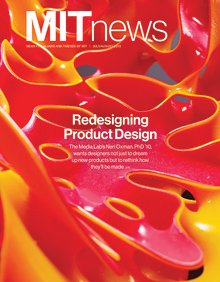Letters
Tackling the Wheelchair Challenge
I read with much interest the article “The Accidental Humanitarian,” on the great efforts of Amos Winter, in the July/August 2013 issue of MIT News. As someone whose own research addresses issues of mobility in the developing world, I am very excited to see one of my peers leading a new wave of innovation in that field.

I started Free Wheelchair Mission (www.freewheelchairmission.org) in 2001 to help provide basic, durable wheelchairs to people with physical disabilities living in poverty in the developing world. Two and a half wheelchair designs and 12 years later, FWM has been able to provide more than 700,000 wheelchairs to people in 87 countries. But both Dr. Winter and I know that the need remains incredibly vast. An estimated 65 million to 120 million people in developing countries need wheelchairs.
Yet when I look at colleagues like Dr. Winter and see that there are so many people out there working toward the same goal, I can only be inspired by the efforts of so many to help their brothers and sisters. I am encouraged by the Leveraged Freedom Chair and the work of GRIT, and I applaud Dr. Winter for his work and research. Thanks to MIT News for bringing it to light.
Don Schoendorfer, SM ’74, PhD ’77
Santa Ana, California
Science, Art, and Millie
After two years as a postdoctoral fellow under Professor Millie Dresselhaus—and 10 more years of collaborating with her—I think I can say today what science is (“The ‘What If?’ Whiz,” May/June 2013). But working with Millie is not only about science; it is about many things, including art. This makes me think: do I know what art is? I’ve read experts saying that a piece of art is so full of meaning that it no longer belongs to its creator. The concepts behind its creation are no longer important, because art belongs to humanity. People will study the artistic work from time to time but will never fully capture its meaning. Time changes, people change, and the artwork remains significant, always teaching us something, always inspiring human beings…The more I think, the more I conclude that Millie herself is a work of art.
Ado Jorio
Professor of Physics Universidade Federal de Minas Gerais
Belo Horizonte, Brazil
MIT’s Postdoctoral Association
MIT’s 1,300 or so postdocs have a lot on their hands; they are driving forward world-class research while preparing their next career move and often starting a family.
Paulina Hill, a postdoc in the Langer lab, recognized that postdocs’ needs are different from those of faculty and students and that postdocs needed a voice at MIT (“Why I Rallied MIT Postdocs,” May/June 2013). And in September 2011, the Postdoctoral Association (PDA) was founded. Supported by Maria Zuber’s Office of the Vice President for Research, the PDA has already achieved many of its initial goals.
With the PDA’s voice, it is now easier for MIT’s leadership to understand the needs and aspirations of postdocs—and easier for postdocs to have a say in Institute decisions that affect them. The PDA helped create the Faculty Postdoctoral Advisory Committee (FPAC) that gathers administrative staff, faculty members, and postdocs to advise the vice president for research on postdoctoral affairs. It is also advocating for more postdocs on institutional committees. Committed to helping postdocs in their professional development, the PDA last year facilitated and secured access to the Writing Center, Infinite Connection accounts, and one-on-one counseling with Career Services. It also began offering travel grants to help postdocs participate in conferences. Inspired by MIT’s vibrant undergraduate and graduate student communities, the PDA is bringing postdocs together around social and scientific events. This is important because a stronger MIT postdoc community will serve postdocs during and after their MIT experiences and could also encourage postdoc alumni to give back in future years.
The PDA offers living proof that postdocs are an active part of the MIT community. Although postdoc turnover is high (the PDA went through four leadership changes in less than two years!), new faces are constantly coming to the PDA to make sure that MIT stays one of the best places in the world for a postdoc to do research.
Thomas Crouzier, PDA president
Cambridge, Massachusetts
Keep Reading
Most Popular
Large language models can do jaw-dropping things. But nobody knows exactly why.
And that's a problem. Figuring it out is one of the biggest scientific puzzles of our time and a crucial step towards controlling more powerful future models.
The problem with plug-in hybrids? Their drivers.
Plug-in hybrids are often sold as a transition to EVs, but new data from Europe shows we’re still underestimating the emissions they produce.
How scientists traced a mysterious covid case back to six toilets
When wastewater surveillance turns into a hunt for a single infected individual, the ethics get tricky.
Google DeepMind’s new generative model makes Super Mario–like games from scratch
Genie learns how to control games by watching hours and hours of video. It could help train next-gen robots too.
Stay connected
Get the latest updates from
MIT Technology Review
Discover special offers, top stories, upcoming events, and more.